Martha Jefferson Randolph
Martha "Patsy" Randolph (née Jefferson; September 27, 1772 – October 10, 1836) was the eldest daughter of Thomas Jefferson, the third President of the United States, and his wife Martha Wayles Skelton Jefferson. She was born at Monticello, near Charlottesville, Virginia.
Martha Jefferson Randolph | |
|---|---|
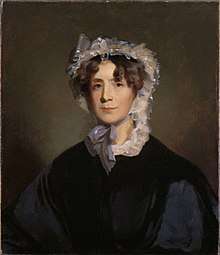 | |
| First Lady of the United States
Acting | |
| In role March 4, 1801 – March 4, 1809 | |
| President | Thomas Jefferson |
| Preceded by | Abigail Adams |
| Succeeded by | Dolley Madison |
| Personal details | |
| Born | Martha Jefferson September 27, 1772 Monticello, Virginia, British America |
| Died | October 10, 1836 (aged 64) Albemarle County, Virginia, U.S. |
| Resting place | Monticello Cemetery |
| Nationality | American |
| Spouse(s) | Thomas Mann Randolph Jr. (m. 1790; died 1828) |
| Children | 12, including Thomas Jefferson Randolph and George W. Randolph |
| Parents | Thomas Jefferson Martha Wayles Skelton |
| Signature | |
Her mother died when she was 10 years old. By that time, only two out of her five siblings were alive. By 1804, she was the lone surviving sibling. Martha was very close to her father in his old age. She was the only one of his children with his wife Martha to survive past age 25. Patsy had a close relationship with her father, who saw that she had a good education. She spoke four languages and was greatly influenced by the education she received in as Paris convent school with daughters of the French elite.
She married Thomas Mann Randolph Jr., who served as a politician at the federal and state levels and was elected a governor of Virginia (1819–1822), making her the First Lady of Virginia. They had twelve children together. When her widowed father was President, she sometimes lived with him at the White House, serving as his hostess and informal First Lady.
Early life
Martha Jefferson was born on September 27, 1772,[1] at Monticello, her father's estate in Virginia (then in British America) to Thomas Jefferson and Martha Wayles Skelton.[2] Her paternal grandparents were Peter Jefferson, a planter and surveyor, and Jane Randolph.[3][4] Her maternal grandparents were John Wayles (1715–1773) and his first wife, Martha Eppes (1712–1748). Wayles was an attorney, slave trader, business agent for Bristol-based merchants Farrell & Jones, and prosperous planter.[5]
During her parents' ten years of marriage, they had six children: Martha "Patsy" (1772–1836); Jane (1774–1775); a son who lived for only a few weeks in 1777; Mary Wayles "Polly" (1778–1804); Lucy Elizabeth (1780–1781); and another Lucy Elizabeth (1782–1784).[6] Only Martha and Mary survived more than a few years.[7]
The family lived a gentile lifestyle and Patsy was initially schooled at home. Her studies included dance lessons.[2] When she was seven years of age, her father became the governor of Virginia. He was elected on June 1, 1779 and the family first lived in Williamsburg. The government moved to Richmond in 1780 and the family relocated there.[2] British troops advanced to Richmond in May 1781 and, due to advance warning, the Jeffersons escaped to their country home, Poplar Forest.[2]
Her mother died on September 6, 1782, four months after the birth of the Jeffersons' last child, at age 33. She later wrote that about this period and her father's grief, stating "in those melancholy rambles I was his constant companion, a solitary witness to many a violent burst of grief."[8][lower-alpha 1] Patsy was 10 years of age when her mother died.[10]
Education

Patsy's father did not believe in public education for girls, but arranged for his daughter to receive a private education.[12] Between December 1782 and May 1784, she boarded with a family and studied French, dancing, drawing, and music with private tutors, who received prescribed, strict daily schedules and instructions regarding how her education should be conducted by Thomas Jefferson. He was particularly focused on cleanliness and spelling, both of which were important to create the image of a proper lady with moral behavior and diction.[2] In the meantime, her father worked in Philadelphia and awaited Congressional orders to go to France.[2]
Her younger sisters, Mary and Lucy Elizabeth, remained in Virginia with family members as Patsy and her father traveled to Boston with James Hemings. They set sail for Paris on the ship Ceres on July 5, 1784 and arrived in France on August 6, 1784.[2] Patsy lived in Paris with her father from age 12 to 17 while he served as U.S. Minister to France. Jefferson enrolled her at the Pentemont Abbey, an exclusive convent school, after receiving assurances that Protestant students were exempt from religious instruction. At this boarding school Patsy learned arithmetic, geography, world history, and Latin, as well as music and drawing.[2] Patsy was deeply influenced by the four years at the convent school. Her peers were the French elite who provide a model of “female intelligence, capacity, and energy” and experienced the "rich pageantry of Roman Catholic liturgies". It impacted her ability to conduct witty, intelligent conversation and how she viewed how she would manage the education of her children.[13] Over the course of her studies, Patsy learned to speak four languages.[12]
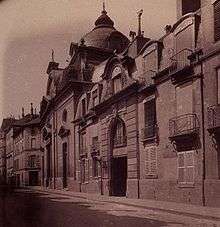
[Martha Jefferson Randolph] was wont to say in after life, that she looked back to her residence in the Convent as to a period of great happiness & great improvement."
— Her daughter, Ellen Randolph Coolidge[14]
In October 1784, her youngest sister, Lucy, died of whooping cough. Mary traveled with Sally Hemings to Paris and joined her sister at the convent school in July 1787.[2] Patsy and Mary contracted typhus during the winter of 1788 and lived with their father until they regained their health. They returned to the convent in spring of 1789.[2] After Patsy expressed a desire to convert to Catholicism and said she was considering religious orders, Jefferson quickly withdrew her and her younger sister Polly from the school.[15] Patsy enjoyed a social life that included balls and concerts during the summer.[2] At her father's residence in Paris, she talked with world leaders.[16] In September 1789, after the beginning of the French Revolution, Thomas Jefferson, his daughters, and James and Sally Hemings sailed for home.[2]
Marriage and family
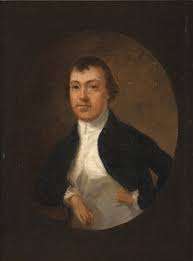
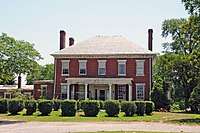
On February 23, 1790, Martha married Thomas Mann Randolph, Jr., a planter, at Monticello. He was her third cousin.[1] Soon after their marriage, her father, Thomas Jefferson, deeded eight slaves from Monticello as a wedding gift, including Molly Hemings, the eldest daughter of Mary Hemings.[17]
The couple first lived at Randolph's estate, Varina, in Henrico County and had thirteen children.[2] In contrast to her parents and sister, each of whom had most of their children die in childhood, eleven of the Randolphs' children survived to adulthood:[2]
- Anne Cary Randolph (1791–1826), who married Charles Lewis Bankhead (1788-1833).[18]
- Thomas Jefferson Randolph (1792–1875), who married Jane Hollins Nicholas (1798-1871).[19]
- Ellen Wayles Randolph (1794–1795), died young during a trip that Patsy and her husband took July 1795 to October 1795 to improve his health.[2]
- Ellen Wayles Randolph (1796–1876), who was named after deceased sister, and was married to Joseph Coolidge (1798-1879)
- Cornelia Jefferson Randolph (1799–1871). In the 1830s, she established a school at Edge Hill, then her brother's estate, where she taught painting, sculpture, and drawing. She translated and published, The Parlor Gardener: A Treatise on the House Culture of Ornamental Plants. Translated from the French and Adapted to American Use. Cornelia never married.[20]
- Virginia Jefferson Randolph (1801–1881), who married Nicholas Philip Trist (1800–1874).[21][22]
- Mary Jefferson Randolph (1803–1876). She lived at Edge Hill and helped her sister-in-law, Jane, supervise the household of her brother Thomas Jefferson Randolph. She and her sister Cornelia also visited the houses of their siblings during times of sickness. She never married.[23]
- James Madison Randolph (1806–1834) was born at the President's House, now called the White House on January 17, 1806.[2]
- Benjamin Franklin Randolph (1808–1871), who married Sally Champe Carter.[24]
- Meriwether Lewis Randolph (1810–1837), who married Elizabeth Martin. After his death, Martin married Andrew Jackson Donelson, a nephew of President Andrew Jackson.
- Unnamed Child Randolph (1811 - 1811), died young
- Septimia Anne Randolph (1814–1887), who married Dr. David Scott Meikleham (d. 1849).[25]
- George Wythe Randolph (1818–1867), who briefly in 1862 was Secretary of War of the Confederate States of America, and who married Mary Elizabeth Adams Pope.[26]
Patsy managed the household affairs at Varina and her father's estate at Monticello in the 1790s.[2] Her husband, the son of Thomas Jefferson's friend Thomas Mann Randolph, Sr., was in many ways a good candidate as her husband, but his family was subject to scandal. Some of the Randolphs were accused but later acquitted of killing a child believed to have been fathered by Richard Randolph.[2] Patsy was a witness in the case of Commonwealth v. Richard Randolph on April 22, 1793. In addition, her father-in-law created a scandal when he married a teenager.[2]
Thomas Jefferson sold the couple land for the Edge Hill plantation so that they could be nearer to him at Monticello in Albemarle County. They built a house and resided there beginning in January 1800. Patsy managed he affairs at both Varina and Monticello.[2] Patsy educated her children at home.[1]
She made several visits to the White House (then known as the President's House) when her father was president. During her visits from November 1802 to January 1803 (with her sister and two of her children) and 1805–1806 (with her entire family), she served as his hostess and informal First Lady[1][2] by organizing Jefferson's social schedule and welcoming guests at receptions held by her father.[27] Author Catherine Allgor notes that she was her father’s confidante and well respected in Washington. Known for her intelligence and role in the social ladder, "whenever she was in the capital, Mrs. Randolph became the head of whatever occasion she attended. No matter what the social skirmish, no one disputed her right of precedence."[28] During that period, from 1803 to 1807, her husband served in the House of Representatives in Washington, D.C.[2]
She possessed a strong and cultivated— mild and gentle temper; warm affectionate—and self-sacrificing in all her duties.
— Thomas Jefferson Randolph[29]
Patsy's sister, Mary "Polly", was also a hostess at times, until she died in 1804 during childbirth.[30] Politically attuned Dolley Madison often performed hostess duties for Jefferson. Her husband, James Madison, was then the Secretary of State and she lived in Washington, D.C.[30] Patsy's eighth child, James Madison Randolph, was born at the President's house on January 17, 1806.[2] Patsy has a calming presence and helped divert attention from the rumors of Jefferson's relationship with Sally Hemings. A visitor said that she provided "the best refutation of all the calumnies that have been heaped upon him."[2]
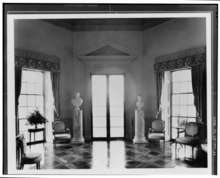
Patsy and her children lived primarily at Monticello after Thomas Jefferson's retirement[1] in 1809.[2] While her husband was the governor of Virginia from 1819 to 1822, she continued to live at Monticello. This was done partly to save money.[2] She managed the household activities at the plantation. She had her own room at Monticello where she was generally on her own. Her husband visited Monticello at times.[10] Concerned about the family's financed and loss of income if her husband served in the military during the War of 1812, Patsy convinced President James Monroe to give him a more lucrative, temporary tax collectorship post.[2]
With three of her children—Mary, Cornelia, and Thomas—she edited the first collection of Jefferson's writings for publication. She worked at spreading untrue claims that denied his paternity of the Hemings children and that would put her father in the best light.[2]
Patsy devoted much of her life to her father's declining years. She had separated from her husband, who was said to suffer from alcoholism and mental instability.[31][32] Jefferson describes her as the "cherished companion of his youth and the nurse of his old age". Shortly before his death, he said that the "last pang of life was parting with her."[33]
Opinions about slavery
Patsy seemed to have mixed feelings about slavery. When she lived in Paris, she learned that there were countries where enslaving people was not legal and said to her father, "I wish with all my soul that the poor Negroes were all freed".[16] She also said she "detested" the unjust treatment of blacks, and the way that it fostered cruelty in whites.[34] She attempted to keep enslaved people with their families when she could, and freed some slaves, but she also used enslavement of others as an economic necessity and selling them as a means to attain money.[2][34] For instance, in 1827, after her father's death, she sold 130 slaves to settle outstanding debts. As a result, families were separated. The remaining enslaved people were her most valuable assets. She generated income when she hired them out to work. She sold two more slaves in 1833.[2]
Her son Thomas unsuccessfully lobbied for a plan for Virginia to abolish slavery gradually and colonize slaves in Africa in 1831, a proposal that Patsy supported. She also considered moving to a free state. Although she gave several enslaved people their freedom in her wills, she relied on their efforts throughout her life.[2]
Later years and death
Patsy dealt with the strain of financial concerns over her debts of her husband, father-in-law, Thomas Mann Randolph, Sr., and her father upon their deaths. They became indebted due to declining land values, risky investments, failed crops and needy relatives.[2] In 1826, her son Thomas purchased the Edge Hill estate.[2] Thomas Jefferson died on July 4, 1826.[2] She inherited Monticello from her father in 1826, as well as his many debts. Her eldest son Thomas Randolph acted as executor of the estate. Except for five slaves freed in her father's will, and "giving her time" (informal emancipation) to Sally Hemings, they sold the remainder of the 130 slaves at Monticello to try to settle the debts.
After Jefferson's death, Patsy lived with Thomas, her eldest son, at Tufton.[1] She stayed at the home of her daughter Ellen and son-in-law Joseph Coolidge in Boston from October 1826 to May 1828. She had her two youngest children with her.[2] She then went to her husband in June 1828 and was at his bedside when he died on the 20th of that month.[1][2]
By this point, she was "living on the edge of poverty".[28] Wanting to ensure successful careers for her family, which included her sons-in-law, she looked to Margaret Bayard Smith, who helped family members procure positions that led to successful careers in Washington.[35] After her husband's death, she lived with her son at Edgehill estate until November 29 and then in Washington, D.C. and Boston with other married children.[1] To generate income, she hired out her remaining slaves. She also had a modest income from bank stock donated in tribute of Jefferson by the states of Louisiana and South Carolina.[2] The state legislatures each donated $10,000 to her for her support.[11] She had a little income from her father's estate.[2]
Patsy put Monticello on the market two weeks following her father's death in July 1826. She attempted to sell it through a lottery, but was unable to sell it until 1831 to a James S.[36] or James T. Barclay in 1831.[37] After having been on the market for five years, the plantation sold for $7,000, 1/10th of its $71,000 value.[36][lower-alpha 2] A school was established at Edge Hill by her unmarried daughters, Mary and Cornelia, and Patsy, who taught music there at times. Patsy also traveled to the homes of her married children in her later years.[2]
While in Boston, she wrote her final will on January 24, 1836 and returned to the Edge Hill estate in July 1836.[2] Patsy died there on October 10, 1836.[1] The last surviving child of Thomas and Martha Jefferson, she was buried at the Monticello family graveyard.[1]
In popular culture
Martha Jefferson Randolph is the subject of the historical novel America's First Daughter by Stephanie Dray and Laura Kamoie, published in March 2016. The novel draws heavily upon Jefferson's letters.[38]
In the 1995 film Jefferson in Paris, Martha Jefferson was portrayed by actress Gwyneth Paltrow.
In the 2000 4-hour CBS miniseries Sally Hemings An American Scandal written by Tina Andrews, Martha Jefferson was portrayed by actress Mare Winningham.
References
Notes
- Not until mid-October 1782 did her father, then 39, begin to resume a normal life when he wrote, "emerging from that stupor of mind which had rendered me as dead to the world as was she whose loss occasioned it."[8] Her mother asked her father to never marry again, and he never did. Her request has been attributed to protective feelings for her children, in view of her mother's own disagreeable relationships with her step-mothers.[9]
- Barclay sold it in 1834 to his uncle Commodore Uriah P. Levy, a United States naval officer. He bought the Monticello mansion and 218 acres for $2,800.[36] Patsy's friends had a plan to gather the funds to buy Monticello, in accordance with Jefferson's wish that Patsy lived at Monticello throughout the remainder of her life, and that it stayed in the family. Levy purchased it, though, before they could make the necessary arrangements.[36]
References
- "Martha Jefferson Randolph". www.monticello.org. Retrieved January 6, 2020.
- Kierner, Cynthia A (May 9, 2008). "Randolph, Martha Jefferson (1772–1836)". Encyclopedia Virginia. Retrieved January 6, 2020.
- Malone, Dumas, ed. (1933). "Jefferson, Thomas". Dictionary of American Biography. 10. Charles Scribner's Sons. pp. 5–6.
- Brodie, Fawn (1974). Thomas Jefferson: An Intimate History. W. W. Norton & Company. pp. 33–34. ISBN 978-0-393-31752-7.
- Tucker, George (1837). The Life of Thomas Jefferson, Third President of the United States; 2 vol. Carey, Lea & Blanchard.
- Meacham, Jon (September 9, 2014). Thomas Jefferson: President and Philosopher. Random House Children's Books. pp. PT277. ISBN 978-0-385-38751-4.
- "Martha Wayles Skelton Jefferson". White House. Retrieved January 7, 2020.
- Watson, Robert P.; Yon, Richard (2003). "The Unknown Presidential Wife: Martha Wayles Skelton Jefferson". Jefferson Legacy Foundation. Archived from the original on October 15, 2013. Retrieved January 7, 2012.
Wayles never remarried but had five children – Nance, Critta, Thenia, Peter, and Sally – to his slave Elizabeth "Betty" Hemings, the youngest of which would become famous for her relationship with Thomas Jefferson.)" Note: This is incorrect on the number and some of the names; see Note for Monticello website
- Hyland Jr., William G. (2015). Martha Jefferson: An Intimate Life with Thomas Jefferson. Lanham, MD: Rowman and Littlefield. p. 1.
- "Martha Jefferson Randolph's Room at Monticello". Monticello. Retrieved January 6, 2020.
- Wayson, Billy L. (2013). Martha Jefferson Randolph: Republican Daughter and Plantation Mistress.
- "Martha Jefferson Randolph - The Monticello Classroom". classroom.monticello.org. Retrieved January 6, 2020.
- "The French Education of Martha Jefferson Randolph". Virginia Humanities. November 15, 2012. Retrieved January 7, 2020.
- "Ellen W. Randolph Coolidge’s Memories of Martha Jefferson Randolph," in Jefferson Quotes and Family Letters Th. Jefferson's Monticello (website), accessed June 30, 2019
- Wead, Doug (2004). All the Presidents' Children: Triumph and Tragedy in the Lives of America's First Families. Simon and Schuster. pp. 127–129.
- Gunning, Sally Cabot (September 17, 2016). "The Strange and Ironic Fates of Jefferson's Daughters". Retrieved January 7, 2020.
- Gordon-Reed, Annette (2009-09-08). The Hemingses of Monticello: An American Family. W. W. Norton & Company. p. 424. ISBN 978-0-393-07003-3.
- "Charles Lewis Bankhead". The Thomas Jefferson Encyclopedia. Retrieved November 16, 2013.
- "Jane Hollins Nicholas Randolph,". The Thomas Jefferson Encyclopedia. Retrieved November 16, 2013.
- "Cornelia Jefferson Randolph". www.monticello.org. Retrieved January 7, 2020.
- "Nicholas Philip Trist". The Thomas Jefferson Encyclopedia. Retrieved November 16, 2013.
- Virginia Jefferson Randolph gravestone
- "Mary Jefferson Randolph". www.monticello.org. Retrieved January 7, 2020.
- "Benjamin Franklin Randolph". The Thomas Jefferson Encyclopedia. Retrieved November 16, 2013.
- "Septimia Ann Randolph Meikleham". The Thomas Jefferson Encyclopedia. Retrieved November 16, 2013.
- "George Wythe Randolph". The Thomas Jefferson Encyclopedia. Retrieved November 16, 2013.
- Andrews, Evan. "Not Every First Lady Has Been Married to the President". History Channel. Retrieved January 7, 2020.
- Allgor, Catherine (2000). Parlor Politics: In which the Ladies of Washington Help Build a City and a Government. University of Virginia Press. pp. 134. ISBN 978-0-8139-2118-1.
- "M.A.R. - Martha Jefferson Randolph". Boston Post. June 5, 1880. p. 5. Retrieved January 7, 2020.
- "Martha Jefferson Randolph, Maria Jefferson Eppes, Dolley Madison". Miller Center, University of Virginia. October 4, 2016. Retrieved January 7, 2020.
- Hart, Priscilla (October 5, 2009). "The Madhouse of Colonial Williamsburg: An Interview With Shomer Zwelling". History News Network. Retrieved March 7, 2011.
- "Martha Wayles Skelton Jefferson" (2009) National First Ladies Library. Retrieved March 7, 2011
- Nock, Albert Jay (1926). Jefferson. Ludwig von Mises Institute. p. 332. ISBN 978-1-61016-419-1.
- Kierner, Cynthia A. (2012-05-14). Martha Jefferson Randolph, Daughter of Monticello: Her Life and Times. Univ of North Carolina Press. p. 11. ISBN 978-0-8078-8250-4.
- Allgor, Catherine (2000). Parlor Politics: In which the Ladies of Washington Help Build a City and a Government. University of Virginia Press. pp. 134-136. ISBN 978-0-8139-2118-1.
- "Renewed Efforts Being Made to Preserve Monticello, Jefferson's Home". Evening Star. June 30, 1912. p. 53. Retrieved January 8, 2020 – via Newspapers.com.
- Dr. James Turner Barclay, Minister and Missionary - Capturing Our Heritage
- Dray, Stephanie; Kamoie, Laura (2016). America's First Daughter. HarperCollins. ISBN 978-0-06-234726-8.
Further reading
- Billy L. Wayson, " 'Considerably different for her sex': A Plan of Reading for Martha Jefferson," The Libraries, Leadership, and Legacy of John Adams and Thomas Jefferson, Robert C. Baron and Conrad Edick Wright, eds. (Fulcrum Publishing and Massachusetts Historical Society, 2010)
External links
- Martha Jefferson Randolph at C-SPAN's First Ladies: Influence & Image
- Who Is a First Lady, Smithsonian Institution
| Honorary titles | ||
|---|---|---|
| Preceded by Abigail Adams |
First Lady of the United States Acting 1801–1809 |
Succeeded by Dolley Madison |
